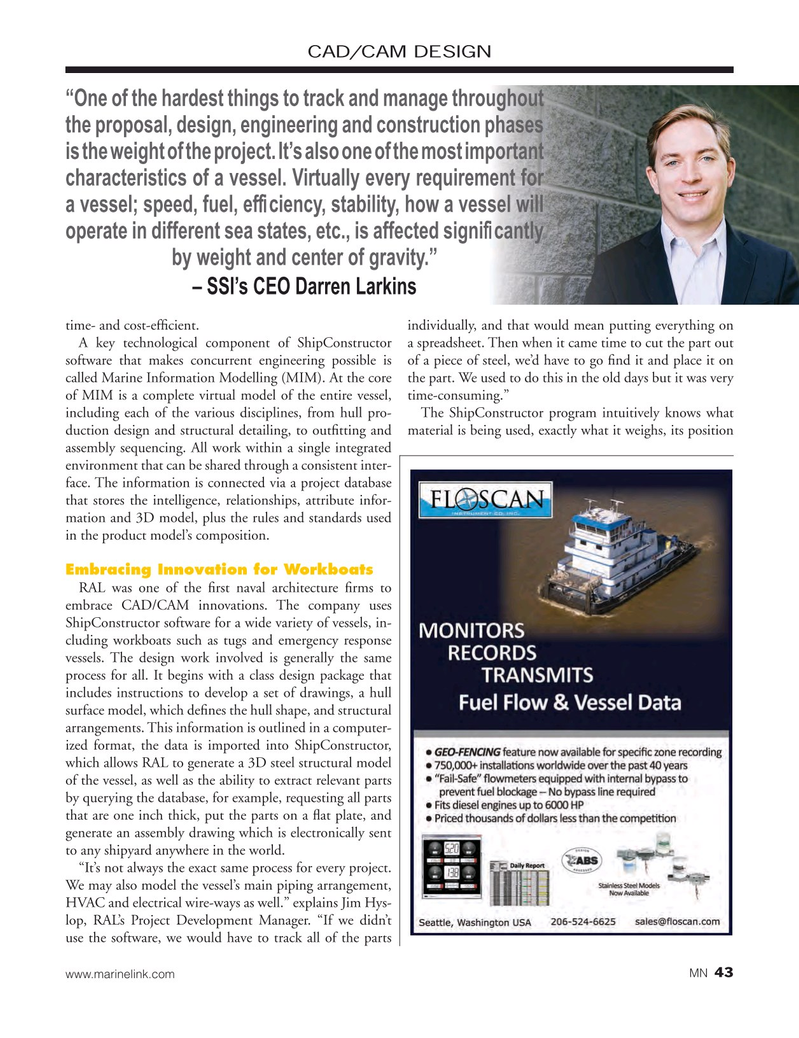
Page 43: of Marine News Magazine (December 2015)
Innovative Products & Boats of 2015
Read this page in Pdf, Flash or Html5 edition of December 2015 Marine News Magazine
CAD/CAM DESIGN “One of the hardest things to track and manage throughout the proposal, design, engineering and construction phases is the weight of the project. It’s also one of the most important characteristics of a vessel. Virtually every requirement for a vessel; speed, fuel, ef? ciency, stability, how a vessel will operate in different sea states, etc., is affected signi? cantly by weight and center of gravity.” – SSI’s CEO Darren Larkins time- and cost-ef? cient. individually, and that would mean putting everything on
A key technological component of ShipConstructor a spreadsheet. Then when it came time to cut the part out software that makes concurrent engineering possible is of a piece of steel, we’d have to go ? nd it and place it on called Marine Information Modelling (MIM). At the core the part. We used to do this in the old days but it was very of MIM is a complete virtual model of the entire vessel, time-consuming.” including each of the various disciplines, from hull pro- The ShipConstructor program intuitively knows what duction design and structural detailing, to out? tting and material is being used, exactly what it weighs, its position assembly sequencing. All work within a single integrated environment that can be shared through a consistent inter- face. The information is connected via a project database that stores the intelligence, relationships, attribute infor- mation and 3D model, plus the rules and standards used in the product model’s composition.
Embracing Innovation for Workboats
RAL was one of the ? rst naval architecture ? rms to embrace CAD/CAM innovations. The company uses
ShipConstructor software for a wide variety of vessels, in- cluding workboats such as tugs and emergency response vessels. The design work involved is generally the same process for all. It begins with a class design package that includes instructions to develop a set of drawings, a hull surface model, which de? nes the hull shape, and structural arrangements. This information is outlined in a computer- ized format, the data is imported into ShipConstructor, which allows RAL to generate a 3D steel structural model of the vessel, as well as the ability to extract relevant parts by querying the database, for example, requesting all parts that are one inch thick, put the parts on a ? at plate, and generate an assembly drawing which is electronically sent to any shipyard anywhere in the world. “It’s not always the exact same process for every project.
We may also model the vessel’s main piping arrangement,
HVAC and electrical wire-ways as well.” explains Jim Hys- lop, RAL’s Project Development Manager. “If we didn’t use the software, we would have to track all of the parts 43 www.marinelink.com MN
MN Dec15 Layout 32-49.indd 43 11/24/2015 9:37:11 AM

 42
42

 44
44
